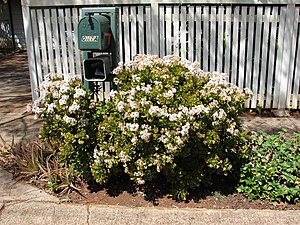Money tree
| Money tree | ||||||||||||
|---|---|---|---|---|---|---|---|---|---|---|---|---|

Money tree ( Crassula ovata ) |
||||||||||||
| Systematics | ||||||||||||
|
||||||||||||
| Scientific name | ||||||||||||
| Crassula ovata | ||||||||||||
| ( Mill. ) Druce |
The money tree ( Crassula ovata ), also known as the penny tree, is a type of plant from the genus thick leaf ( Crassula ). It is a floral element of the Cape flora (Capensis).
description
Vegetative characteristics
Crassula ovata grows as an upright, rounded, thick-stemmed, heavily branched, evergreen shrub and reaches heights of up to 2.5 meters. The base is usually only sparsely branched. Sometimes a single main stem up to 6 centimeters in diameter is formed. The succulent shoots are gray-green. The bark of older twigs peels off in horizontal, brownish stripes.
The oppositely arranged, rising to spread out, green leaves are short stalked with up to 5 millimeters. The fleshy, bald, obovate, at the base wedge-shaped leaf blade is 3 to 9 inches long and 1.8 to 4 inches wide. The spreader tip is pointed and often has an attached tip. The sharp-edged leaf margins are often reddish in color.
Generative characteristics
The flowering time in South Africa is in the cool winter months from June to August. The terminal inflorescence is a round thyrsus with numerous dichasias . It has a length and a diameter of about 5 centimeters. The peduncle has a length of 15 to 18 millimeters and a diameter of 2 millimeters. The flower stalks are 5 millimeters long.
The sweet smelling, hermaphrodite flowers are radial symmetry and five-fold with a double flower envelope . The five approximately 2 millimeter long sepals are fused together at their base. The pink or white corolla is star-shaped and about 15 millimeters in diameter. Your lanceolate petals are 7 millimeters long and 2.5 millimeters wide. The stamens have a length of 5 millimeters.
The capsule fruit contains many tiny seeds.
Occurrence
Crassula ovata is distributed on rocks in the South African provinces of Eastern Cape and KwaZulu-Natal in the Valley Bushveld. The distribution area extends from Willowmore to East London and north to Queenstown and KwaZulu-Natal. Crassula ovata grows together with Aloe , Euphorbia species, Portulacaria afra and other succulent plant species.
Taxonomy
It was first described as Cotyledon ovata in 1768 by Philip Miller . George Claridge Druce put the species in the genus Crassula in 1917 . A nomenclature synonym is Toelkenia ovata (Mill.) PVHeath (1993). Other synonyms are Crassula argentea Thunb. (1778), Crassula portulacea Lam. (1786), Crassula obliqua Aiton (1789), Crassula articulata Zuccagni (1806), Crassula nitida Schönland (1903) and Crassula lucens Gram (1941).
use
The money tree is used with some elite forms as an ornamental plant in subtropical gardens and as a houseplant . Cultivars of Crassula ovata are for example “Gollum” and “Hobbit”.
The Khoi and other African peoples ate the roots cooked. The leaves were boiled in milk and used in folk medicine.
proof
literature
- Urs Eggli (ed.): Succulent lexicon. Crassulaceae (thick leaf family) . Eugen Ulmer, Stuttgart 2003, ISBN 3-8001-3998-7 , pp. 66 .
Individual evidence
- ↑ a b c d e f Urs Eggli (Ed.): Sukkulenten-Lexikon. Crassulaceae (thick leaf family) . Eugen Ulmer, Stuttgart 2003, ISBN 3-8001-3998-7 , p. 66.
- ↑ a b c d e f g Christien Malan, Alice Notten: Crassula ovata at PlantzAfrica . (accessed October 31, 2011).
- ^ The Gardeners Dictionary . 8th edition 1768 (online)
- ^ Botanical Society and Exchange Club of the British Isles 1917 . 1917, p. 617.


